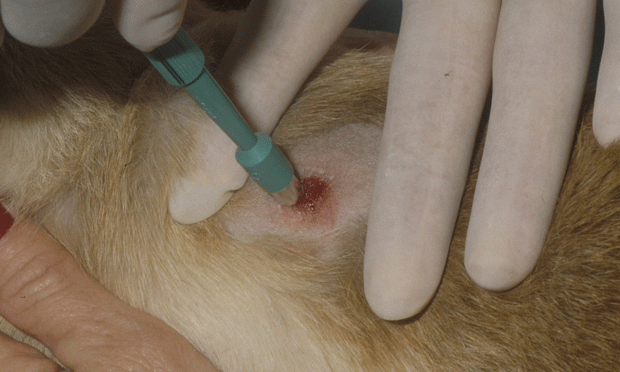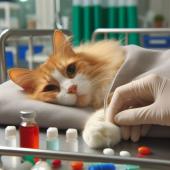Biopsy in Cats: Understanding the Procedure, Importance, and Aftercare

Biopsy
Your pet may undergo a biopsy to determine if a growth is cancerous or noncancerous (benign). The tissue removed during a biopsy is examined under a microscope by a veterinary pathologist, a specialist in examining cells and tissue samples.
What is a biopsy?
A biopsy is a surgical procedure in which a tissue sample is removed from the body and examined under a microscope. In some cases, only a small sample is removed for analysis - in other cases, several samples may be removed, or an entire growth may be removed and examined.
Why does my pet need a biopsy?
Dogs and cats commonly develop lumps and growths on their skin. Sometimes these are cancerous, but they can be warts or other noncancerous (benign) growths. Your vet may not tell from examining a lump whether it is cancerous or not, so may recommend a biopsy to obtain more information about a suspicious lump.
A biopsy can also be used to diagnose a condition or determine the severity of a disease. If a pet has liver disease, a sample of the liver can be removed by biopsy and examined under a microscope to help determine the cause and extent of the liver damage.
Why Biopsies are Important
Biopsies are essential for several reasons:
-
Accurate Diagnosis: Biopsies allow veterinarians to accurately diagnose various conditions, including tumors, infections, and inflammatory diseases.
-
Treatment Planning: The results of a biopsy help veterinarians determine the most appropriate treatment plan, whether it involves surgery, medication, or other therapies.
-
Prognosis: Biopsies can provide valuable information about the prognosis, enabling pet owners to make informed decisions about their cat's care.
Types of Biopsies
-
Fine Needle Aspiration (FNA): FNA involves using a thin needle to withdraw a sample of cells from a lump or mass. It's a relatively non-invasive procedure.
-
Incisional Biopsy: In this type, a small portion of the abnormal tissue is surgically removed for examination. This method is common when the entire mass cannot be removed easily.
-
Excisional Biopsy: The complete removal of the abnormal tissue is performed, often followed by histopathological examination to determine the nature of the growth.
What happens during a biopsy?
Your pet will generally require some form of anaesthesia for a biopsy. Your vet will decide whether to use local anaesthesia, sedation, or general anaesthesia depending on where the tissue sample is located and how many areas need to be sampled.
Local anaesthesia involves injecting a medication in and around an area of the body to make it numb. With local anesthesia, your pet will likely be awake during the biopsy. If sedation or general anaesthesia is used, the patient is heavily sedated or completely asleep during the biopsy. If a growth is on the surface of the skin and is very small, the biopsy may be carried out using local anesthesia, but if the area to be biopsied is within the abdomen, or if multiple areas will be biopsied, general anaesthesia is usually recommended.
In an incisional biopsy, a small sample of tissue is removed from a larger mass. In an excisional biopsy, the entire growth is removed and submitted for biopsy.
Once the tissue is removed, the sample will be examined at a diagnostic laboratory where a veterinary pathologist (a specialist at examining cells and tissue samples) will examine the tissue under a microscope to make a diagnosis. Results are generally available within several days.
The Biopsy Procedure
-
Anesthesia: Most biopsies require anesthesia to ensure the cat remains still and pain-free during the procedure.
-
Sample Collection: Depending on the type of biopsy, the veterinarian collects a sample of cells or tissue from the abnormal area using a needle or surgical procedure.
-
Suturing and Bandaging: If necessary, the biopsy site is sutured, and a bandage may be applied to prevent infection and promote healing.
-
Recovery: Cats are monitored during recovery to ensure they wake up from anesthesia smoothly. They may be kept in the hospital for observation for a short period.
Are there any risks?
Biopsies are very important for helping to confirm a diagnosis. Early diagnosis is helpful for determining the course of treatment with many types of cancer and can help increase the chance of survival. Biopsies can also help to confirm causes of other conditions, including skin lesions as well as diseases of the kidneys, liver, or bone marrow.
Your vet will take precautions to ensure that your pet is safe during the biopsy and recovers fully afterward. To help reduce the risk of complications associated with surgery or anaesthesia, your vet may give your pet a full physical examination and take blood samples before the biopsy.
Biopsies are very safe, routine procedures. Any risks associated with a biopsy depend on the overall health of the pet, the location of the area to be biopsied, and how many samples are taken. Your vet will be happy to discuss any concerns that you may have.
Aftercare and Monitoring
-
Pain Management: Veterinarians often prescribe pain medications to keep the cat comfortable during the recovery period.
-
Activity Restriction: Cats should be kept quiet and restricted from vigorous activities to prevent disruption of the biopsy site.
-
Preventing Licking or Chewing: The cat should wear an Elizabethan collar to prevent licking or chewing at the biopsy site, which can lead to complications.
-
Monitoring for Complications: Watch for signs of infection, such as redness, swelling, or discharge, and contact the veterinarian if you notice any abnormalities.
-
Follow-up Appointments: Attend follow-up appointments as scheduled to discuss the biopsy results and the next steps in your cat's treatment plan.
Conclusion
Biopsies are invaluable tools in diagnosing and treating various medical conditions in cats. By understanding the importance of this procedure, pet owners can actively participate in their cat's healthcare journey. With appropriate veterinary care, meticulous aftercare, and open communication with your veterinarian, you can ensure your feline companion receives the best possible treatment and support throughout the biopsy process and beyond.





